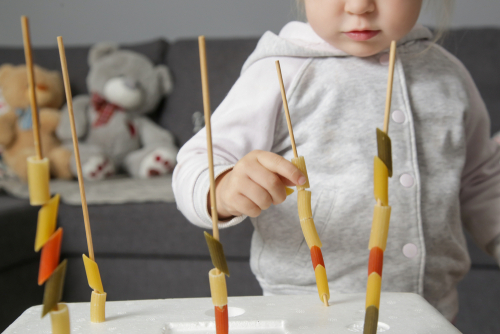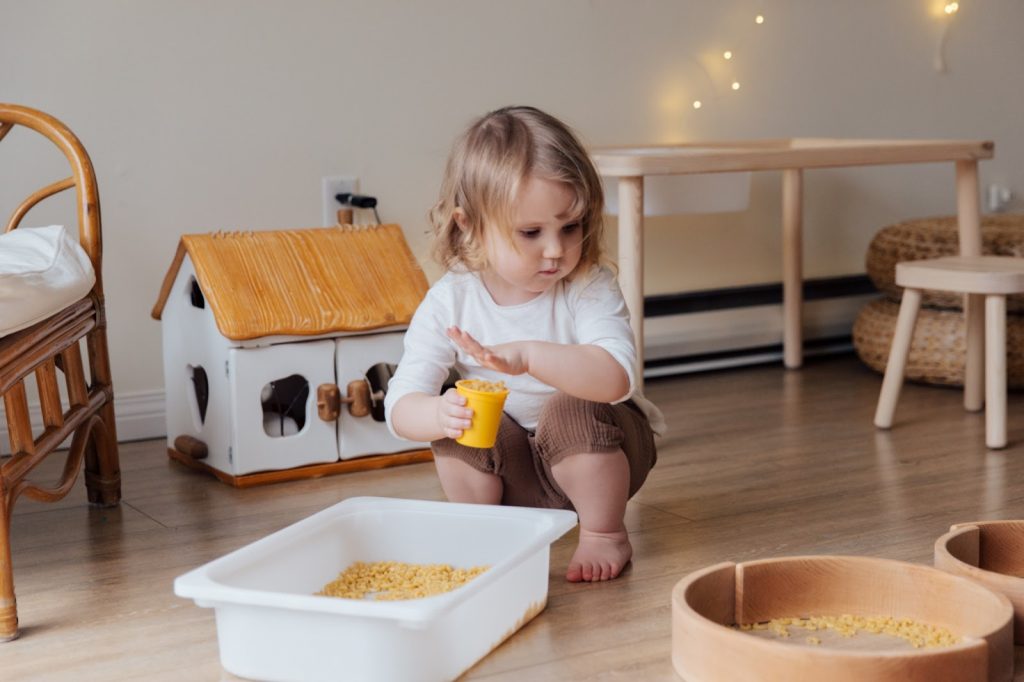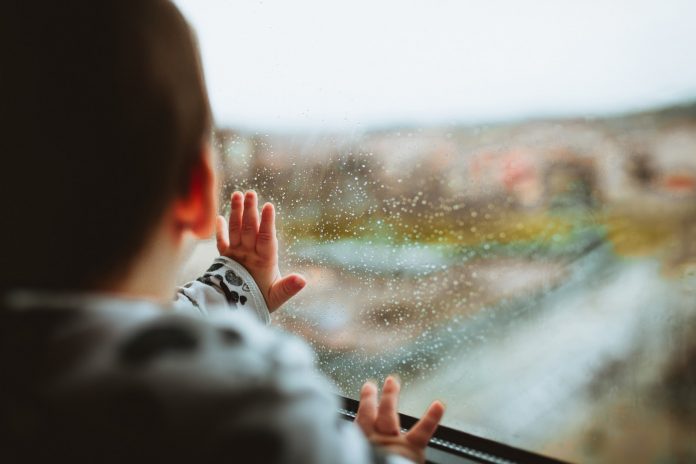Whether it’s a rainy day out or you feel like staying home, going outdoors may not always be an option. Finding age-appropriate activities for 1-year-olds that you can try with your toddler can be tricky sometimes, especially when you’re stuck (or choose to be) indoors.
16 Indoor Activities for 1-Year-Olds

We’ve curated the best indoor activities for 1-year-olds to help them learn and have fun simultaneously. And the best part is that you can try these out with your child from the comfort of your home.
Math & ELA | PreK To Grade 5
Kids see fun.
You see real learning outcomes.
Watch your kids fall in love with math & reading through our scientifically designed curriculum.
Parents, try for free Teachers, use for free
1. Threading Pasta
What you will need:
Hollow dry pasta such as rigatoni and some dough (or playdough )
What to do:
Threading pasta can be a great way to develop a child’s fine motor skills. All you have to do is stick some straws into dough or playdough and ensure the straws stay upright. Rigatoni pasta works great for this, but any pasta with a donut-like hole should do. Regarding creative indoor activities for one-year-olds, threading pasta is unlike any other.
What your child will learn:
Your child will develop their fine motor skills and hand–eye coordination with this activity.
2. Putting Toys Away After Playtime
What you will need:
Just your toddler and the toys they have finished playing with
What to do:
As fun, as it is for a child to play with toys, it can be just as fun to put them away if you know how to make a game out of it! You can take turns with your toddler tossing their toys back to their box or the space where they belong.
You can take this further by encouraging your child to color-coordinate their toys as they’re being put away. Educational activities for 1-year-olds don’t always have to involve books. Sometimes, helping toddlers put away their toys can be quite educational indeed.
What your child will learn:
Color-coordinating toys as they’re put away after playtime is a great way to develop your child’s coordination skills.
Related Reading: Best Fun Games for Toddlers that Effortlessly Boost their Growth & Development
3. Poking Shoeboxes
What you will need:
An empty shoebox (or any similar kind of cardboard box) and some golf tees
What to do:
If you’re looking for a quick and easy way to entertain infants, all you need to get started is an empty shoebox and some golf tees. Children love poking golf tees into the shoebox. Demonstrate how golf tees can be poked into cardboard, and watch your child follow along.
What your child will learn:
Inserting golf tees is a tactile activity that promotes the development of fine motor skills.
4. Nursery Rhymes
What you will need:
Just your toddler and a collection of their favorite nursery rhymes
What to do:
You could sing a new nursery rhyme to your child every day until they’re ready for elementary school and still not run out of new rhymes. They remain one of the most popular ways to engage children, and for good reason. Watch as their ears perk up, and they clap along to the rhymes you share with them.
What your child will learn:
Reading nursery rhymes out loud to children will develop their listening skills and encourage the development of their musical preferences by exploring new rhymes.
Related Reading: Children’s Songs When You Want to Dance With Your Kids
5. Looking Through Photographs
A photo album, wall paintings at home, or any images you have should work fine.
What to do:
Engaging by showing photographs and paintings can be a fun exercise for kids. You can walk around and give them a tour of what your home (or daycare) displays on the walls.
What your child will learn:
Looking through images should allow toddlers to enhance their sustained attention.
6. Making Music
What you will need:
Spoons, pots, pans, drums, cymbals, or anything else that can be struck against other items to produce unique sounds
What to do:
Sit down with your child and show them how to make music using spoons, pots, pans, drums, cymbals, and other percussion instruments. Before you know it, your child will be rocking away independently. You can put on some music and play an instrument to the sound or create your own.
What your child will learn:
Making music is a great way to engage your child’s motor and listening skills. Their capacity for auditory discrimination stands to benefit as well.
7. Pretending to Talk on the Phone
What you will need:
Any two small items that can pass as a phone
What to do:
Start by handing your child one of the items and holding the other yourself. Talk into the item and pretend you’re speaking into a phone. Your child should follow suit as if responding to your verbal queues. You can even make silly sounds and mimic characters to evoke responses from your child.
What your child will learn:
This activity should help develop your child’s listening skills and capacity for one-on-one correspondence.

8. Playing House
What you will need:
A cardboard large enough for your child to move around in
What to do:
You can use a cardboard box to create a small house (or castle) and encourage your child to enter and explore this space. You can even pretend to ring the doorbell and ask if someone is home to make this activity more engaging. With so many fun activities for 1-year-olds, playing house offers something fun and unique.
What your child will learn:
This activity can stimulate a child’s desire to learn more about their environment.
Related Reading: Best Concentration Games for Kids to Develop Super Focus & Attention Skills
9. Talking through a Cardboard Tube
What you will need:
All you need is a hollow cardboard tube
What to do:
Make yourself and your child comfortable by finding a space to place a hollow cardboard tube between yourselves and watch the magic unfold. If you’re looking for a way to help your child familiarize themselves with new sounds and voices, you can try speaking to them through a cardboard tube to see how they react to changes in your voice.
What your child will learn:
Your child should be able to improve their capacity for one-on-one correspondence and improve their listening skills.
10. Playing With Sand
What you will need:
A small bucket or a tub, along with some sand and water
What to do:
Prepare a small bucket or a tub with a mixture of sand and water that is thick enough to be molded into shapes not unlike dough. Allowing your child to play with a bucket or tub filled with sand and water should help them exercise creativity to experiment with shapes and patterns. You can even try making some of your own and seeing if your child follows your lead.
What your child will learn:
This tactile activity should encourage creativity in kids while improving their fine motor skills.
11. Self-Awareness Activity
What you will need:
All you need for this is red lipstick (any other bright color should work just as well)
What to do:
To get started, use red lipstick to make a small mark on your child’s nose or forehead. Once you have done that, place them before a mirror so they can see themself. This may evoke a response from your child, as they recognize themselves and notice that there’s something different about their appearance.
Infants don’t have a strong sense of self at this age, but they do have an idea of what they look like and can recognize themself. Even if your child doesn’t recognize the mark or react, don’t worry. They should be able to identify the mark soon enough once they grow older.
What your child will learn:
As the name suggests, this self-awareness activity should develop your child’s self-awareness.
Related Reading: Best Fun Games for Toddlers that Effortlessly Boost their Growth & Development
12. Moving within a “Tunnel”
What you will need:
A set of puzzles, toys, or objects that can be used to lay out two lines across the room
What to do:
Use a set of puzzles, toys, or other items to lay out two sets of lines across a room. These lines should serve as a “tunnel,” the margins within which your child should move around. Encourage your child to move within this “tunnel” to see how well they can stay within the margins you have laid for them. Learning activities for 1-year-olds can be tricky to find, but this game combines the best of both worlds.
What your child will learn:
Moving within this “tunnel” should encourage your child’s desire for exploration while improving their gross motor skills.
13. Grooving to Music
What you will need:
A television, laptop, cellphone, or any electronic device with speakers
What to do:
After selecting a device, play music to see how your child reacts to sounds. You can shuffle through different types of music before you find something your child enjoys grooving. To ensure that the volume stays within a safe margin. In indoor activities for 1-year-olds, grooving to music is tough to beat.
What your child will learn:
Listening to music should encourage their desire for musical exploration while improving their listening skills.
14. Counting Fingers and Toes
What you will need:
All you need for this activity is your child
What to do:
Count through different numbers as you raise the corresponding number of fingers. Have your child participate by holding their toes and fingers to do the same. Explaining the concept of numbers may seem challenging, but you can rely on your fingers and toes to tackle the abstract nature of numbers.
The visual and physical stimuli provided by fingers and toes help make learning easier for your child. With so many activities for 1-year-olds at home to pick from, this activity offers toddlers an opportunity to learn counting while having fun, the perfect blend!
What your child will learn:
Using toes and fingers can help develop basic number skills while improving sustained attention.
15. Playing Fetch
What you will need:
Your child is all you need for this one
What to do:
You must have simple objects like books, shoes, or utensils scattered around your house. Use verbal and physical cues to encourage your child to fetch objects they may recognize. This activity can reward your child with a sense of accomplishment and independence whenever they return with the object you asked them to fetch. If you’re looking for activities for 12-month-olds that combine learning with fun, playing fetch is sure to amuse.
What your child will learn:
Having your child fetch objects is a simple but effective way of improving their language skills by recognizing directions.
16. Have Fun with Bath Time
What you will need:
Water-friendly toys, or cups, pots, and pans should also suffice
What to do:
All you need for a fun bath time are some toys. Even if you don’t have toys suitable for bath time, worry not. You can use a cup, or even pots and pans, to see how your child reacts to the movement of water across these utensils and learn how water moves, smells, and tastes. Feel free to add a baby-friendly bath bomb to make things extra fun.
What your child will learn:
This sensory experience develops your child’s motor skills and capacity for creative play.
Related Reading: Best STEAM Activities to Make Learning Fun for Kids of All Ages
Impacts of Learning Activities on Kids

Activities are key to nurturing children’s growth mindset, development, learning, confidence, and well-being. Their playtime must be varied to ensure that children make the most of education through activities! Whether their playtime is structured or unstructured, indoors or outdoors, they must engage in various activities.
The outdoors can be great for toddlers, but you can always get comfy at home when they aren’t an option. And that’s fine because these indoor activities for 1-year-olds are a great alternative to outdoor fun games, and combined with an element of learning, they help your toddler make the most of their playtime.
Explore more online educational resources for kids that will help with their learning experience and make them smarter.
Related Reading: Best Indoor and Outdoor Team Building Activities for Kids
Frequently Asked Questions (FAQs)
Can these activities be taken outdoors?
As long as your toddler is engaged and enjoying themselves, it shouldn’t matter whether you’re indoors or outdoors. Bathtime fun could just as well be an afternoon spent in your backyard pool, teaching your toddler how to swim.
Why should I try these activities with my 1 year old?
Whether you’re helping them thread a string through dry, hollow pasta or encouraging them to let their imagination run amok as they paint using their hands, these activities can be great bonding exercises. While the specific advantages of these home and daycare activities for 1-year-olds may vary, they’re a great way to build your relationship with your child.
























